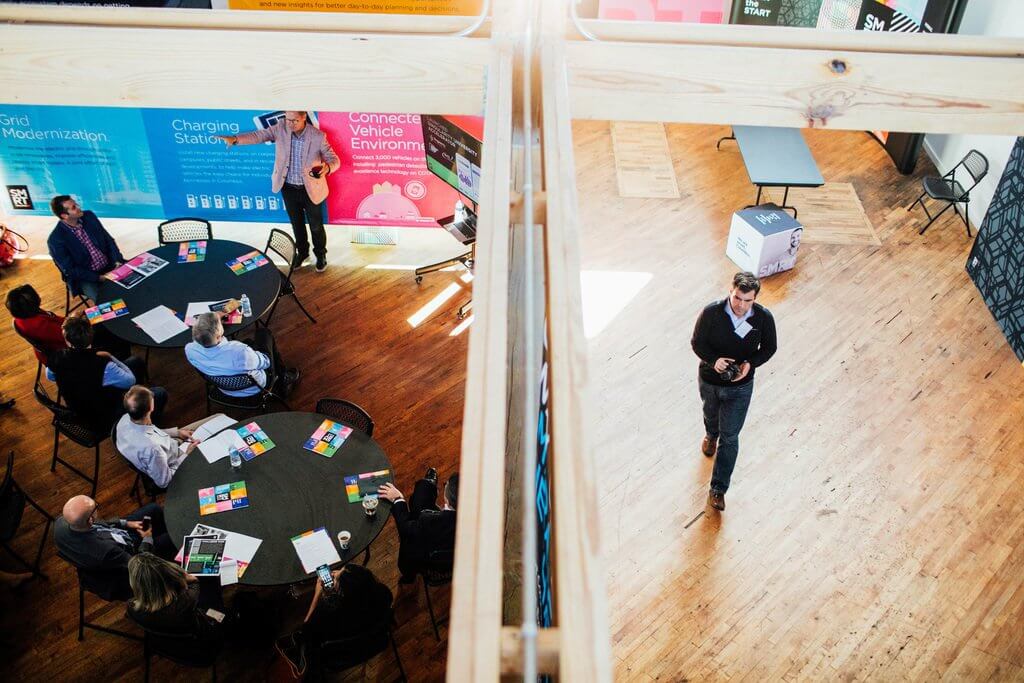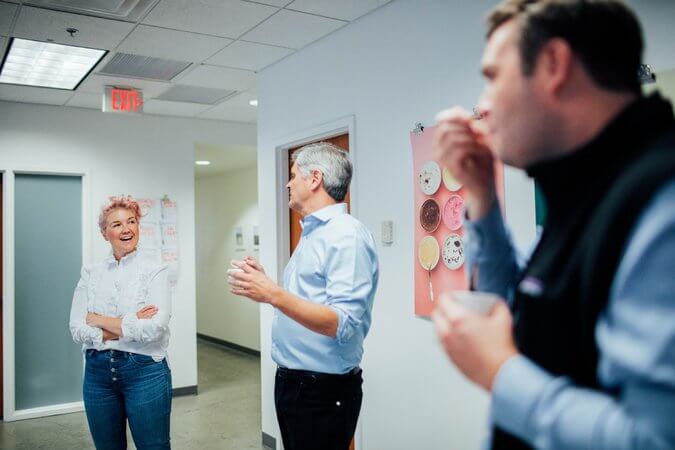As Silicon Valley Gets ‘Crazy,’ Midwest Beckons Tech Investors
 COLUMBUS, Ohio — They seem an odd couple. J. D. Vance, author of “Hillbilly Elegy,” his best-selling memoir of growing up in the postindustrial Midwest and his journey of escape. And Steve Case, the billionaire co-founder of America Online.
COLUMBUS, Ohio — They seem an odd couple. J. D. Vance, author of “Hillbilly Elegy,” his best-selling memoir of growing up in the postindustrial Midwest and his journey of escape. And Steve Case, the billionaire co-founder of America Online.
But Mr. Vance joined Mr. Case’s investment firm this year to scour the Midwest for small yet promising start-ups, particularly for a new seed fund. The firm, Revolution, plans to raise up to $100 million for that fund’s investments, it disclosed in a filing last month with the Securities and Exchange Commission.
They are by no means the only notable investors seeking opportunity in the region.
Four years ago, Mark Kvamme, a top venture capitalist in Silicon Valley, left the heart of the tech industry to become a tech investor here in the Midwest heartland.
After a slow start, his firm has raised $550 million and invested in 26 companies. Its bet is that the middle of America amounts to an undervalued asset, rich in markets, new business ideas and budding entrepreneurs. The Midwest, the thinking goes, is not only untapped, but also an antidote to the scalding-hot tech market on the West Coast.
“Silicon Valley is kind of crazy now,” Mr. Kvamme said.
The money, power and influence of tech companies on the West Coast have reached new heights. Apple, Alphabet, Microsoft and Amazon are now the four most valuable companies in the country.
Venture capital, the financial fuel for new companies, is also concentrated on the coast. More than 50 percent of all venture capital money spent in the United States goes to companies in California alone, according to the National Venture Capital Association.
But some investors, led by people like Mr. Kvamme and his firm, Drive Capital, see plenty of potential in the center of the country. Focusing on the Midwest is no longer considered a nutty idea, as it was by skeptical West Coast venture capitalists when Mr. Kvamme and Chris Olsen, another Silicon Valley transplant from Sequoia Capital and co-founder of Drive Capital, made the move in 2013.
Every major Midwestern city now has clusters of start-up accelerators and incubators, typically housed in renovated red-brick industrial buildings.
And a couple of big bets have been successful: CoverMyMeds, an Ohio start-up, whose software streamlines drug prescribing, was sold to McKesson this year for $1.1 billion, and Salesforce bought ExactTarget, a maker of marketing software in Indiana, for $2.5 billion in 2013.

Deals like those are still rare. But local entrepreneurs and big investors are scouting the Midwest for start-up investments that range up to tens of millions of dollars, far more than local angel and venture investors. And they are beginning to attract venture capital from Silicon Valley for follow-on rounds of funding.
The rationale for investing in the Midwest combines cost and opportunity. A top-flight software engineer who is paid $100,000 a year in the Midwest might well command $200,000 or more in the Bay Area. The Midwest, the optimists say, also has ample tech talent, with excellent engineers coming out of major state and private universities in the region.
But they also point to technology shifts. As technology transforms nontech industries like health care, agriculture, transportation, finance and manufacturing, the Midwest investors argue that being close to customers will be more important than being close to the wellspring of technology.
“The value will come from marrying industry knowledge with technology,” said Mr. Olsen of Drive Capital. “There’s an arrogance in Silicon Valley that we don’t need industry expertise. That’s going to be less and less true in the future.”
But broadening the geography of innovation-fueled economic growth will require capital. Today, three-quarters of all venture capital invested in America goes to California, New York and Massachusetts, the National Venture Capital Association estimated. Ohio gets less than 1 percent and the 12-state Midwest region less than 10 percent in total, according to figures compiled by the State Science and Technology Institute.
“There are two Americas,” Mr. Case said. “One with an abundance of capital and opportunity — in Silicon Valley and pockets around the nation. But not in the other America, and that other America is most of the country.”
Mr. Case served on White House advisory councils on jobs, innovation and entrepreneurship during the Obama administration, and that experience, he said, shaped his thinking about investing in the Midwest. Since 2011, his firm has raised more than $1 billion for two funds, Revolution Ventures and Revolution Growth, which generally make investments of $4 million to $50 million, including in start-ups in the Midwest.
Referring to the troubles chronicled in his book, Mr. Vance said that “at least a partial solution is to get more investment capital into this part of the country.”
The firm also sponsors road trips in a colorfully painted bus that it calls Rise of the Rest, also the name of Revolution’s new $100 million investment fund. Mr. Case and members of his team leave Revolution’s base in Washington, D.C., to visit and champion emerging start-up communities in cities across the country. Since 2014, there have been six such tours, and the most recent one ended last month after stops in central Pennsylvania; Ann Arbor, Mich.; Indianapolis; Columbus; and Green Bay, Wis.
The days are packed with meetings with local entrepreneurs, investors, corporate executives, government officials, educators and social service workers. Each day ends with a pitch contest, where eight to 10 start-ups present their companies and business plans.
The winner in each city receives a check for $100,000, a personal investment from Mr. Case. So far, he has handed out more than $4 million in the local contests.
The day in Columbus was typical. There were seven stops, including three start-up hubs, with Mr. Case and Mr. Vance listening and speaking at each location.
Mr. Case and Mr. Vance talk of the need to create “network density” by bringing together more entrepreneurs, customers, partners and investment capital. The trips can and do yield investment candidates for Revolution, but start-up evangelism is the main theme.
There are encouraging signs in Columbus. The city’s start-up clusters are full of activity. At the Idea Foundry, a two-story refurbished factory, one tenant is the Smart Columbus project. Last year, Columbus beat out several locations — including San Francisco; Austin, Tex.; Denver; and Portland, Ore. — to win a $50 million federal Transportation Department “smart city” grant. That was initial funding for a public-private partnership to develop technology to tackle problems from managing self-driving car traffic to reducing infant mortality.
The Kauffman Foundation, which studies start-up activity, reported last month that Columbus ranked third among 40 metropolitan areas in “growth entrepreneurship,” the share of start-ups that employ 50 or more workers within 10 years.
CrossChx, a five-year-old start-up with a payroll of 80 people, is one of them. The company, which makes health care software, has raised $35 million of venture funding in three rounds. Drive Capital spotted the company, led the early financing and has since been joined by Bay Area investors including Khosla Ventures and Silicon Valley Bank.
In Ohio, that $35 million is the equivalent of $70 million in the Valley in terms of being able to hire talent and sustain operating costs, said Sean Lane, CrossChx’s co-founder and chief executive.
“I’m not sure we would have made it through the zigs and zags if we were in the Valley,” Mr. Lane said.
CrossChx is one of more than two dozen companies in Drive Capital’s portfolio. To date, none have folded, and they are generating more than $150 million in revenue. After three years — its first fund started investing in 2014 — the firm’s gains look good on paper. But it is too early to declare its Midwest bet a success.
That will take a few more years, and the proof will be if it delivers high returns to its limited-partner investors. “And if two guys from Silicon Valley and Sequoia can’t do it,” Mr. Olsen said, “capital isn’t going to come here.”
